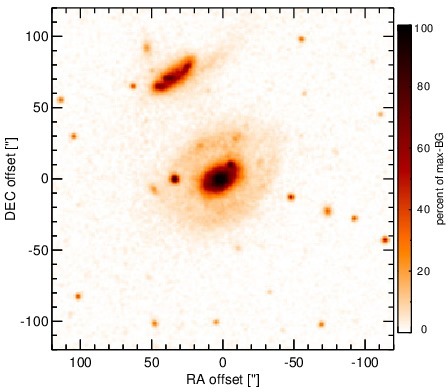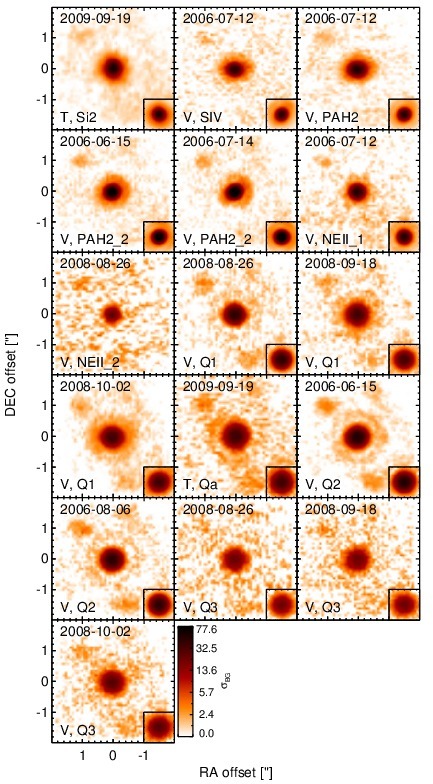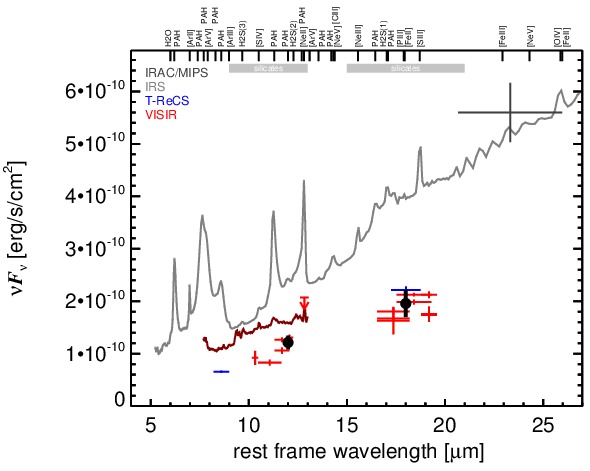Sasmirala Individual Information for NGC 7469
Description
NGC 7469 is a low-inclination infrared-luminous barred spiral galaxy at a redshift of z = 0.0163 (D ~ 67.9 Mpc) and one of the original six Seyfert galaxies [seyfert_nuclear_1943]. It is presumably interacting with the nearby irregular galaxy IC 5283 ~ 22 kpc to the north, forming the pair Arp 298. The AGN is optically classified either as Sy 1.0, Sy 1.2 or Sy 1.5 (see [osterbrock_spectroscopic_1993]) and surrounded by a powerful starburst with ~ 5arcsec ~ 1.6 kpc diameter (e.g. [wilson_starburst_1991, genzel_infrared_1995, diaz-santos_resolving_2007]). NGC 7469 also belongs to the nine-month BAT AGN sample. It features a compact radio core at arcsecond resolution, which is slightly elongated in the east-west direction [wilson_starburst_1991]. The radio core is resolved into several compact sources with a maximum separation of ~ 0.17arcsec ~ 54 pc along the same direction at milliarcsecond scales (PA~ 85∘; [lonsdale_starburst-agn_1993, lonsdale_vlbi_2003]). This objects has been extensively studied in the MIR since the pioneering observations by [kleinmann_observations_1970] (1970; [rieke_infrared_1972, rieke_infrared_1978, lebofsky_extinction_1979, aitken_question_1981, malkan_stellar_1983, ward_continuum_1987, carico_iras_1988, roche_atlas_1991, keto_subarcsecond_1992, wynn-williams_luminous_1993]). The first subarcsecond-resolution MIR image obtained with Palomar 5 m/SpectroCam-10 was presented by [miles_high-resolution_1994, miles_high-resolution_1996]. This image resolved for the first time the compact nucleus clearly from the patchy starburst ring with ~ 3arcsec ~ 1 kpc diameter in the MIR. The same structure was also visible in following MIR images [soifer_high_2003, gorjian_10_2004, galliano_mid-infrared_2005, raban_core_2008]. In addition, NGC 7469 was observed with the space-based ISO [rigopoulou_large_1999, thornley_massive_2000, tran_isocam-cvf_2001] and Spitzer/IRAC, IRS and MIPS. The corresponding IRAC and MIPS images are completely dominated by a bright nucleus with the spiral-like host emission being only visible in the former (see also [smith_spitzer_2007]). The post-BCD IRAC images are saturated and thus not analysed (but see [gallimore_infrared_2010]). Our nuclear MIPS 24 μm photometry agrees with [u_spectral_2012]. The IRS LR staring-mode spectrum exhibits strong PAH emission and a red spectral slope in νFν-space. Weak 10 and 18 μm silicate emission features might be present but are diluted by the PAH features (see also [buchanan_spitzer_2006, wu_spitzer/irs_2009, gallimore_infrared_2010]). Thus, the arcsecond-scale MIR SED is heavily affected and possibly even dominated by star formation (see also [alonso-herrero_local_2012]). The complex morphology and strong PAH emission complicate a comparison with the historical MIR photometry, but the data indicates no significant flux variations in the last ~ 40 years. The nuclear region of NGC 7469 was imaged with VISIR in four different N-band and three Q-band filters between 2006 and 2008 (partly published in [horst_mid_2008, horst_mid-infrared_2009, reunanen_vlt_2010]). In addition, a VISIR LR N-band spectrum was obtained [honig_dusty_2010-1]. Further imaging data was taken by T-ReCS in the Si2 and Qa filters in 2009 [ramos_almeida_testing_2011]. In all cases, the compact nucleus was detected, while only the brightest knots of the starburst ring are visible in most images (see [ramos_almeida_testing_2011] for an analysis of the starburst knots). The nucleus appears marginally resolved in the VISIR N-band images (FWHM(major axis)~ 0.4arcsec ~ 130 pc; PA~ 85∘), while it remains unresolved in the sharpest Q-band images. Note that the elongation is roughly parallel to the radio morphology. Our corresponding unresolved nuclear fluxes are generally consistent with the PSF-scaled flux measurements from [reunanen_vlt_2010] and [ramos_almeida_testing_2011], while the total nuclear fluxes agree with the photometry from [horst_mid_2008] and the VISIR spectrum from [honig_dusty_2010-1] within the uncertainties. Note that the VISIR NEII_2 measurement is treated as an upper limit on the unresolved flux because it lacks a suitable standard star observation. The resulting nuclear MIR SED is ~ 64% lower than the Spitzer spectrophotometry and does not exhibit significant PAH emission, which indicates that the AGN has been successfully isolated. Furthermore, we can conclude that star formation indeed dominates the MIR emission of the central ~ 1 kpc in NGC 7469. Note that the MIR nucleus of NGC 7469 was recently further resolved with MIR interferometric observations and was modelled as two approximately equally bright components, one extending by ~ 28 pc, and one remaining unresolved (~ 8 pc; [tristram_parsec-scale_2009, burtscher_diversity_2013]).
- [aitken_question_1981] D. K. Aitken, P. F. Roche, and M. M. Phillips. The question of extinction in active galactic nuclei - infrared spectral observations of NGC 1614, NGC 7469 and NGC 1275 . MNRAS , 196 pp. 101P–107P, September 1981.
- [alonso-herrero_local_2012] Almudena Alonso-Herrero, Miguel Pereira-Santaella, George H. Rieke, and Dimitra Rigopoulou. Local luminous infrared galaxies. II. active galactic nucleus activity from Spitzer/Infrared spectrograph spectra . ApJ , 744 pp. 2, January 2012.
- [buchanan_spitzer_2006] Catherine L. Buchanan, Jack F. Gallimore, Christopher P. O'Dea, Stefi A. Baum, David J. Axon, Andrew Robinson, Moshe Elitzur, and Martin Elvis. Spitzer IRS spectra of a large sample of seyfert galaxies: A variety of infrared spectral energy distributions in the local active galactic nucleus population . AJ , 132 pp. 401–419, July 2006.
- [burtscher_diversity_2013] L. Burtscher, K. Meisenheimer, K. R. W. Tristram, W. Jaffe, S. F. Hönig, R. I. Davies, M. Kishimoto, J.-U. Pott, H. Röttgering, M. Schartmann, G. Weigelt, and S. Wolf. A diversity of dusty AGN tori. data release for the VLTI/MIDI AGN large program and first results for 23 galaxies . A&A , 558 pp. 149, October 2013.
- [carico_iras_1988] David P. Carico, D. B. Sanders, B. T. Soifer, J. H. Elias, K. Matthews, and G. Neugebauer. The IRAS bright galaxy sample. III - 1-10 micron observations and coadded IRAS data for galaxies with l(IR) equal to or greater than 10 to the 11th solar luminosities . AJ , 95 pp. 356–373, February 1988.
- [diaz-santos_resolving_2007] T. Díaz-Santos, A. Alonso-Herrero, L. Colina, S. D. Ryder, and J. H. Knapen. Resolving the stellar populations in the circumnuclear ring of NGC 7469 . ApJ , 661 pp. 149–164, May 2007.
- [galliano_mid-infrared_2005] E. Galliano, D. Alloin, E. Pantin, P. O. Lagage, and O. Marco. Mid-infrared imaging of active galaxies. active nuclei and embedded star clusters . A&A , 438 pp. 803–820, August 2005.
- [gallimore_infrared_2010] J. F. Gallimore, A. Yzaguirre, J. Jakoboski, M. J. Stevenosky, D. J. Axon, S. A. Baum, C. L. Buchanan, M. Elitzur, M. Elvis, C. P. O'Dea, and A. Robinson. Infrared spectral energy distributions of seyfert galaxies: Spitzer space telescope observations of the 12 μm sample of active galaxies . ApJS , 187 pp. 172–211, March 2010.
- [genzel_infrared_1995] R. Genzel, L. Weitzel, L. E. Tacconi-Garman, M. Blietz, M. Cameron, A. Krabbe, D. Lutz, and A. Sternberg. Infrared imaging and spectroscopy of NGC 7469 . ApJ , 444 pp. 129–145, May 1995.
- [gorjian_10_2004] V. Gorjian, M. W. Werner, T. H. Jarrett, D. M. Cole, and M. E. Ressler. 10 micron imaging of seyfert galaxies from the 12 micron sample . ApJ , 605 pp. 156–167, April 2004.
- [honig_dusty_2010-1] S. F. Hönig, M. Kishimoto, P. Gandhi, A. Smette, D. Asmus, W. Duschl, M. Polletta, and G. Weigelt. The dusty heart of nearby active galaxies. i. high-spatial resolution mid-IR spectro-photometry of seyfert galaxies . A&A , 515 pp. 23, June 2010.
- [horst_mid-infrared_2009] H. Horst, W. J. Duschl, P. Gandhi, and A. Smette. Mid-infrared imaging of 25 local AGN with VLT-VISIR . A&A , 495 pp. 137–146, February 2009.
- [horst_mid_2008] H. Horst, P. Gandhi, A. Smette, and W. J. Duschl. The mid IR - hard x-ray correlation in AGN and its implications for dusty torus models . A&A , 479 pp. 389–396, February 2008.
- [keto_subarcsecond_1992] Eric Keto, Roger Ball, John Arens, Garrett Jernigan, and Margaret Meixner. Subarcsecond mid-infrared imaging of the nuclei of the infrared bright galaxies NGC 1614 and NGC 7469 . ApJ , 389 pp. 223–226, April 1992.
- [kleinmann_observations_1970] D. E. Kleinmann and F. J. Low. Observations of infrared galaxies . ApJL , 159 pp. L165, March 1970.
- [lebofsky_extinction_1979] M. J. Lebofsky and G. H. Rieke. Extinction in infrared-emitting galactic nuclei . ApJ , 229 pp. 111–117, April 1979.
- [lonsdale_starburst-agn_1993] Colin J. Lonsdale, Harding J. Smith, and Carol J. Lonsdale. The starburst-AGN connection - a sensitive VLBI survey of luminous IRAS galaxies . ApJL , 405 pp. L9–L12, March 1993.
- [lonsdale_vlbi_2003] Carol J. Lonsdale, Colin J. Lonsdale, Harding E. Smith, and Philip J. Diamond. VLBI imaging of luminous infrared galaxies: Active galactic nucleus cores in markarian 231, UGC 5101, and NGC 7469 . ApJ , 592 pp. 804–818, August 2003.
- [malkan_stellar_1983] M. A. Malkan and A. V. Filippenko. The stellar and nonstellar continua of seyfert galaxies nonthermal emission in the near-infrared . ApJ , 275 pp. 477–492, December 1983.
- [miles_high-resolution_1994] J. W. Miles, J. R. Houck, and T. L. Hayward. High-resolution mid-infrared observations of NGC 7469 . ApJ , 425 pp. L37–L40, April 1994.
- [miles_high-resolution_1996] J. W. Miles, J. R. Houck, T. L. Hayward, and M. L. N. Ashby. High-resolution mid-infrared imaging of infrared-luminous galaxies . ApJ , 465 pp. 191, July 1996.
- [osterbrock_spectroscopic_1993] Donald E. Osterbrock and Andre Martel. Spectroscopic study of the CfA sample of seyfert galaxies . ApJ , 414 pp. 552–562, September 1993.
- [raban_core_2008] D. Raban, B. Heijligers, H. Röttgering, K. Meisenheimer, W. Jaffe, H. U. Käufl, and T. Henning. The core flux of the brightest 10 μm galaxies in the southern sky . A&A , 484 pp. 341–345, June 2008.
- [ramos_almeida_testing_2011] C. Ramos Almeida, N. A. Levenson, A. Alonso-Herrero, A. Asensio Ramos, J. M. Rodríguez Espinosa, A. M. Pérez García, C. Packham, R. Mason, J. T. Radomski, and T. Díaz-Santos. Testing the unification model for active galactic nuclei in the infrared: Are the obscuring tori of type 1 and 2 seyferts different? . ApJ , 731 pp. 92, April 2011.
- [reunanen_vlt_2010] J. Reunanen, M. A. Prieto, and R. Siebenmorgen. VLT diffraction-limited imaging at 11 and 18μm of the nearest active galactic nuclei . MNRAS , 402 pp. 879–894, February 2010.
- [rieke_infrared_1972] G. H. Rieke and F. J. Low. Infrared photometry of extragalactic sources . ApJL , 176 pp. L95, September 1972.
- [rieke_infrared_1978] G. H. Rieke. The infrared emission of seyfert galaxies . ApJ , 226 pp. 550–558, December 1978.
- [rigopoulou_large_1999] D. Rigopoulou, H. W. W. Spoon, R. Genzel, D. Lutz, A. F. M. Moorwood, and Q. D. Tran. A large mid-infrared spectroscopic and near-infrared imaging survey of ultraluminous infrared galaxies: Their nature and evolution . AJ , 118 pp. 2625–2645, December 1999.
- [roche_atlas_1991] Patrick F. Roche, David K. Aitken, Craig H. Smith, and Martin J. Ward. An atlas of mid-infrared spectra of galaxy nuclei . MNRAS , 248 pp. 606–629, February 1991.
- [seyfert_nuclear_1943] Carl K. Seyfert. Nuclear emission in spiral nebulae. . ApJ , 97 pp. 28, January 1943.
- [smith_spitzer_2007] Beverly J. Smith, Curtis Struck, Mark Hancock, Philip N. Appleton, Vassilis Charmandaris, and William T. Reach. The spitzer spirals, bridges, and tails interacting galaxy survey: Interaction-induced star formation in the mid-infrared . AJ , 133 pp. 791–817, March 2007.
- [soifer_high_2003] B. T. Soifer, J. J. Bock, K. Marsh, G. Neugebauer, K. Matthews, E. Egami, and L. Armus. High spatial resolution mid-infrared observations of three seyfert galaxies . AJ , 126 pp. 143–152, July 2003.
- [thornley_massive_2000] Michele D. Thornley, Natascha M. Förster Schreiber, Dieter Lutz, Reinhard Genzel, Henrik W. W. Spoon, Dietmar Kunze, and Amiel Sternberg. Massive star formation and evolution in starburst galaxies: Mid-infrared spectroscopy with the ISO short wavelength spectrometer . ApJ , 539 pp. 641–657, August 2000.
- [tran_isocam-cvf_2001] Q. D. Tran, D. Lutz, R. Genzel, D. Rigopoulou, H. W. W. Spoon, E. Sturm, M. Gerin, D. C. Hines, A. F. M. Moorwood, D. B. Sanders, N. Scoville, Y. Taniguchi, and M. Ward. Isocam-cvf 5-12 micron spectroscopy of ultraluminous infrared galaxies . ApJ , 552 pp. 527–543, May 2001.
- [tristram_parsec-scale_2009] K. R. W. Tristram, D. Raban, K. Meisenheimer, W. Jaffe, H. Röttgering, L. Burtscher, W. D. Cotton, U. Graser, Th. Henning, Ch. Leinert, B. Lopez, S. Morel, G. Perrin, and M. Wittkowski. Parsec-scale dust distributions in seyfert galaxies. results of the MIDI AGN snapshot survey . A&A , 502 pp. 67–84, July 2009.
- [u_spectral_2012] Vivian U, D. B. Sanders, J. M. Mazzarella, A. S. Evans, J. H. Howell, J. A. Surace, L. Armus, K. Iwasawa, D.-C. Kim, C. M. Casey, T. Vavilkin, M. Dufault, K. L. Larson, J. E. Barnes, B. H. P. Chan, D. T. Frayer, S. Haan, H. Inami, C. M. Ishida, J. S. Kartaltepe, J. L. Melbourne, and A. O. Petric. Spectral energy distributions of local luminous and ultraluminous infrared galaxies . ApJS , 203 pp. 9, November 2012.
- [ward_continuum_1987] Martin Ward, Martin Elvis, G. Fabbiano, N. P. Carleton, S. P. Willner, and A. Lawrence. The continuum of type 1 seyfert galaxies. i - a single form modified by the effects of dust . ApJ , 315 pp. 74–91, April 1987.
- [wilson_starburst_1991] A. S. Wilson, T. T. Helfer, C. A. Haniff, and M. J. Ward. The starburst ring around the seyfert nucleus in NGC 7469 . ApJ , 381 pp. 79–84, November 1991.
- [wu_spitzer/irs_2009] Yanling Wu, Vassilis Charmandaris, Jiasheng Huang, Luigi Spinoglio, and Silvia Tommasin. Spitzer/IRS 5-35 μm low-resolution spectroscopy of the 12 μm seyfert sample . ApJ , 701 pp. 658–676, August 2009.
- [wynn-williams_luminous_1993] C. G. Wynn-Williams and E. E. Becklin. Luminous infrared galaxies - sizes at 10-32 microns . ApJ , 412 pp. 535–540, August 1993.
Images

Optical image (DSS, red filter). Displayed are the central 4 arcmin with North being up and East to the left. The colour scaling is linear with white corresponding to the median background (BG) and black to the 0.01% pixels with the highest intensity.

Spitzer MIR images. Displayed are the inner 40 arcsec with North being up and East to the left. The colour scaling is logarithmic with white corresponding to median BG and black to the 0.1% pixels with the highest intensity. The label in the bottom left states instrument and central wavelength of the filter in micron (I: IRAC, M: MIPS).

Subarcsecond-resolution MIR images sorted by increasing filter central wavelength. Displayed are the inner 4 arcsec with North being up and East to the left. The colour scaling is logarithmic with white corresponding to median BG and black to the 75% of the highest intensity of all images in units of sig_bg. The inset image (where present; either bottom or top right) shows the central arcsecond of the PSF from the calibrator star, scaled to match the science target. The labels in the bottom left state instrument and filter names (C: COMICS, M: Michelle, T: T-ReCS, V: VISIR).
SEDs


MIR SED. The description of the symbols in all the SED plots (where present) is the following: Grey crosses and solid lines mark the Spitzer/IRAC, MIPS and IRS data. The colour coding of the other symbols is as follows: green for COMICS, magenta for Michelle, blue for T-ReCS and red for VISIR data. Darker-coloured solid lines mark spectra of the corresponding instrument. The black filled circles mark the nuclear 12 and 18 micron continuum emission estimate from the data (where present). The ticks on the top axis mark positions of common MIR emission lines, while the light grey horizontal bars mark wavelength ranges affected by the silicate 10 and 18 micron features.